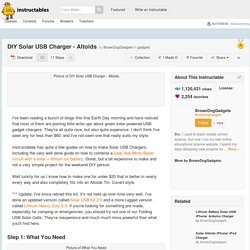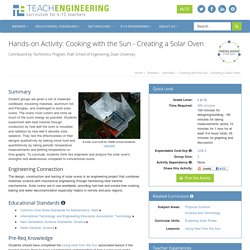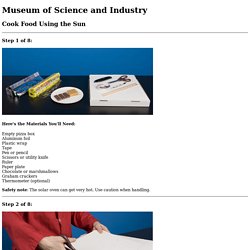

Solar Bag. You'll get "carried away" experimenting with the Solar Energy Bag!

Use the Solar Bag to demonstrate concepts of energy, thermodynamics, density, and buoyancy! Take the 50-foot long, 36 inch diameter tube outdoors and fill it with air. Close the end, tether with string, and allow the sun's energy to heat the air in the bag. In a few minutes, the bag begins to float! Challenge students to explain their observations using kinetic theory and gas laws. WHAT DOES IT TEACH? Includes: 50'x36" bag, kite string, and detailed instructions. Recommend but not included: Meterstick (P1-1070), Infrared Thermometer (68-6505 or 68-6500), scissors, and 2-inch roll cellophane packing tape Products being sold are not toys. Build-it-Yourself Solar LED Flashlight Kit. DIY Bottle Thermometer . Adventures in Learning . PBS Parents. Wind Powered Music Box. Wind_Tubes.pdf. Windmill_Design_0.pdf. DIY Solar USB Charger - Altoids. If we use two rechargeable AAs that put out a total of 2.4Vs we're going to need a solar panel that is at least 3 - 4Vs just to meet basic levels of charging.

The higher the voltage of our solar cell (or cells) the less light we need to charge up our batteries. Now we're also trying to fit this into an Altoids Tin, so we're limited in space. I have found some great 4V solar cells that perfectly fit into Altoids Tins. They're the same ones I use with my Solar AA Altoids Charger. Sure, a bigger and better solar cell would give us added power, but it wouldn't fit into our tin.
You could also use a combination of several smaller cells to get your four volts. Just remember that when charging NiMh batteries we don't want to throw more than 10% of their capacity at them at any one time. $4 Solar Battery Charger. Cooking with the Sun - Creating a Solar Oven. Summary Student groups are given a set of materials: cardboard, insulating materials, aluminum foil and Plexiglas, and challenged to build solar ovens.

The ovens must collect and store as much of the sun's energy as possible. Students experiment with heat transfer through conduction by how well the oven is insulated and radiation by how well it absorbs solar radiation. They test the effectiveness of their designs qualitatively by baking some food and quantitatively by taking periodic temperature measurements and plotting temperature vs. time graphs. To conclude, students think like engineers and analyze the solar oven's strengths and weaknesses compared to conventional ovens. Engineering Connection The design, construction and testing of solar ovens is an engineering project that combines materials science with mechanical engineering through harnessing heat transfer mechanisms.
Educational Standards Click on the standard groupings to explore this hierarchy as it applies to this document. MSI - Online Activities - Cook Food Using the Sun. Step 1 of 8: Here's the Materials You'll Need: Empty pizza boxAluminum foilPlastic wrapTapePen or pencilScissors or utility knifeRulerPaper plateChocolate or marshmallows Graham crackersThermometer (optional) Safety note: The solar oven can get very hot.

Use caution when handling. Step 2 of 8: Draw a square around the lid of the pizza box about 2 inches away from the sides. KidWind Basic Turbine Building Parts. Solar Town Kit. MSI - Online Activities - Build a Wind Turbine. Step 1 of 7: Here's the Materials You'll Need: Three PVC pipes, one about 30 cm long and the others at least 15 cm longThree PVC T-jointsOne PVC elbow jointMotorWire (about two feet long)Wire cuttersHub (available from Kid Wind Project)Wood dowelsMultimeterAlligator clipsScissorsTapeHair dryer or fanMaterials for blades, such as balsa wood, aluminum foil, construction paper, popsicle sticks, etc.

Step 2 of 7: Insert a 15-cm PVC pipe into the middle hole of a PVC T-joint. Repeat with another 15-cm PVC pipe and T-joint. Step 3 of 7: Insert the remaining PVC pipe into the T-joint hole that is facing up, so that the pipe stands upright. Step 4 of 7: Attach two wires to the motor. Attach the plastic, round piece called the hub to the straight, metal piece on the outside of the motor. KidWind Basic Wind Experiment Kit.